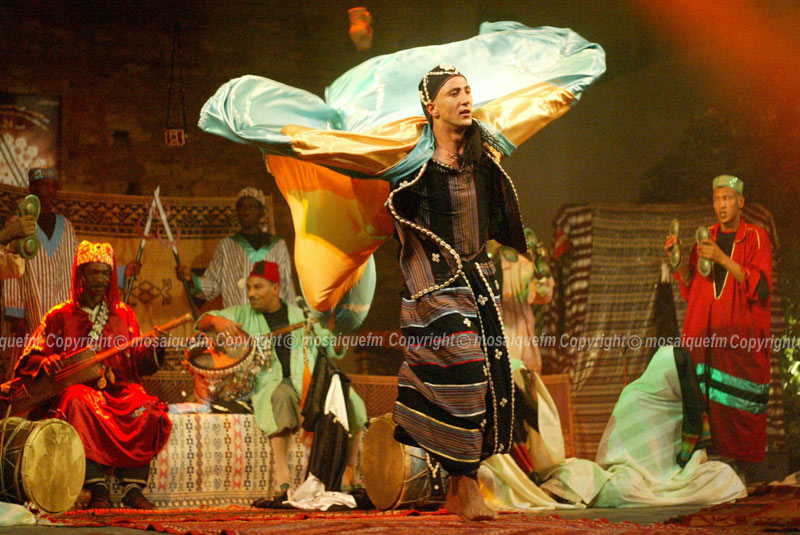
In Tunisia, the history of stambali goes back to the arrival of the first slaves from Mali, Timbuktu specifically. Practicing their music and worship in the house of their masters, the slaves and their musical traditions survive in 2012 through the stambali. However as this musical heritage that ritual could well disappear. Indeed if there are still some ten years, Tunis counted four “houses” of stambali (Dar Bernou, Dar Couffa, Dar Jmaa and Dar Sidi Ali Lasmar) and Sfax two houses (Zaouia Sidi Mansour and Leila Samra ), it remains the only one currently, Dar Sidi Ali Lasmar. The latter hosts the last twenty years stambali a troupe led by Riadh Ezzawech which perpetuates this African traditions and tries to promote through festive performances between tradition and modernity.
You should know that in Tunis as in Sfax these houses of slaves had been offered to them by their master so they can live in community. Each house was run by a “master” of the called Baba Guelledina community. Thus in Tunis, Baba Nasser was managing the affairs of Dar Couffa, Baba Saïd Bernou ; that of Dar Bernou, Umma Zinebou, that of Dar Jmaa and Baba Abdou Kinkara, that of Dar Sidi Ali Lasmar. In the aftermath of the independence;
Habib Bourguiba in his desire to modernize the country has striven to close these homes and to destroy them. The only one who survived Dar Sidi Lasmar which in an advanced state of dilapidation, was bought by an individual in 1964 and hosts a new stambali Brotherhood since 1989.
Returning to stambali rite itself, as we have already said, it is a ritual music and a cult of possession that draw origins of the African presence slaves and descendants of black slaves which mingled local beliefs related to the cults of the saints in popular Islam (wali).
In Dar Sidi Ali Lasmar three stambali ceremonies are held each year: one before Ramadan in the month of Sha’ban (Chaabânia ceremony), a second on 27 Ramadan and finally last night Mouled (Mouloudia). These, orchestrated by the Arrifa that is to say, the “patron saint” of the brotherhood, Riadh Ezzawech, takes place from 14h to the dawn of the next morning. In an introductory section (from 14h to about 20h) based instruments (qraqeb, castanets iron guembri guitar to 3 strings of African origin which can be added the Tbal the courcoutou and songs based on ceremonies) followed by a sacred repertoire characterized by ritual songs in Hausa language which, referring to Bori cult, call for a pantheon of djinn or mlouk (engineering, mind). While fans and dancers engage in trance. This dance and practice of ritual possession, where followers trance embody supernatural entities, have the effect of treating certain ailments, exorcise demons, to ward off the evil eye and to appease the wrath of the spirits. The “master musician” Arrifa, connects him from midnight until dawn, a series of sung currencies, which refers to each entity of Bori pantheon.
What future for this musical heritage so that ritual in Tunisia of the XXI century? While archaeological and natural sites are classified and preserved when it is of this intangible heritage that reminds us musically and ritually the African contribution of the Tunisian people? Riadh Zawech, patron saint of the Brotherhood understands the urgency to keep memory of what he does that is why it offers parallel to purely ritual ceremonies intimate shows / most festive event and ceremonies. Identified by ONTT he sometimes receives groups of tourists or trade delegations to talk about his art. Just a few years he had even had the urge to set foot in Ghar el melh in the Zaouia Sidi Ali Mekki, a Stambali Festival brings together international troops as there is a Gwana Festival in Essaouira in Morocco since 15 years. The Ministry of Culture has never seen the interest and the project remained in a state of lack of financial support the project. Meanwhile the troops of Sidi Ali Lasmar is invited everywhere on the planet to play and make known this tradition and Tunisian heritage. It will happen March 27, 2013 in Grasse theater in France in the World Music Festival.
While zaouïas linked to the cult of saints or to Sufism are attacked in our country in recent times (Sidi Abdelkhader, Lella of Manoubia) and the cult of saints and all that do not will comfort a Wahhabi vision of Islam appears to be rejected with violence, what future for stambali? While Morocco has made the Gnawa, the Moroccan equivalent of stambali, a cultural and tourist product that weighs in the economic balance of the country, Tunisia looks heritage disappear. A mess for future generations.
AM
For more information: www.stambalisidialilasmar.com
The next evening stambali Tunis to Sidi Ali Lasmar will be held February 2, 2013 (Mouloudia).
{Mainvote}


 َAbonnez-vous
َAbonnez-vous

